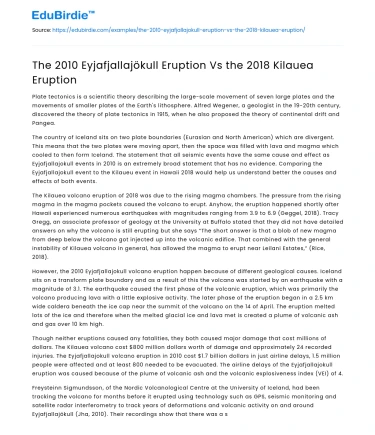Plate tectonics is a scientific theory describing the large-scale movement of seven large plates and the movements of smaller plates of the Earth's lithosphere. Alfred Wegener, a geologist in the 19-20th century, discovered the theory of plate tectonics in 1915, when he also proposed the theory of continental drift and Pangea.
The country of Iceland sits on two plate boundaries (Eurasian and North American) which are divergent. This means that the two plates were moving apart, then the space was filled with lava and magma which cooled to then form Iceland. The statement that all seismic events have the same cause and effect as Eyjafjallajokull events in 2010 is an extremely broad statement that has no evidence. Comparing the Eyjafjallajokull event to the Kilaueu event in Hawaii 2018 would help us understand better the causes and effects of both events.
Save your time!
We can take care of your essay
- Proper editing and formatting
- Free revision, title page, and bibliography
- Flexible prices and money-back guarantee
The Kilauea volcano eruption of 2018 was due to the rising magma chambers. The pressure from the rising magma in the magma pockets caused the volcano to erupt. Anyhow, the eruption happened shortly after Hawaii experienced numerous earthquakes with magnitudes ranging from 3.9 to 6.9 (Geggel, 2018). Tracy Gregg, an associate professor of geology at the University at Buffalo stated that they did not have detailed answers on why the volcano is still erupting but she says “The short answer is that a blob of new magma from deep below the volcano got injected up into the volcanic edifice. That combined with the general instability of Kilauea volcano in general, has allowed the magma to erupt near Leilani Estates,” (Rice, 2018).
However, the 2010 Eyjafjallajokull volcano eruption happen because of different geological causes. Iceland sits on a transform plate boundary and as a result of this the volcano was started by an earthquake with a magnitude of 3.1. The earthquake caused the first phase of the volcanic eruption, which was primarily the volcano producing lava with a little explosive activity. The later phase of the eruption began in a 2.5 km wide caldera beneath the ice cap near the summit of the volcano on the 14 of April. The eruption melted lots of the ice and therefore when the melted glacial ice and lava met is created a plume of volcanic ash and gas over 10 km high.
Though neither eruptions caused any fatalities, they both caused major damage that cost millions of dollars. The Kilauea volcano cost $800 million dollars worth of damage and approximately 24 recorded injuries. The Eyjafjallajokull volcano eruption in 2010 cost $1.7 billion dollars in just airline delays, 1.5 million people were affected and at least 800 needed to be evacuated. The airline delays of the Eyjafjallajokull eruption was caused because of the plume of volcanic ash and the volcanic explosiveness index (VEI) of 4.
Freysteinn Sigmundsson, of the Nordic Volcanological Centre at the University of Iceland, had been tracking the volcano for months before it erupted using technology such as GPS, seismic monitoring and satellite radar interferometry to track years of deformations and volcanic activity on and around Eyjafjallajökull (Jha, 2010). Their recordings show that there was a swollen flank around the volcano which means there was lava underneath the ground.
So, even though both volcanos caused lots of damage and cost lots of money, economically, the Eyjafjallajökull caused more damage but more people were injured in the Kilauea eruption. The cause of the Eyjafjallajökull volcanic eruption was primarily an earthquake with a magnitude of 3.1, which then caused the first phase of the eruption to occur. By the time of the next phase of the volcano 25% of the ice around the volcano melted and caused a flood, and when it came into contact with the lava, it caused a plume of volcanic ash. The effect of the eruption was more the lingering volcanic ash in the atmosphere which caused delayed flights and lots of money lost (approx. $1.7 billion). The cause of the Kilauea eruption was pressure from the rising magma in the magma pockets after numerous earthquakes with magnitudes of 4.4. the effects were $800 million with of damage and about 24 recorded injuries. Answering the research question, the Kilauea volcanic eruption of 2018 did not have the same cause and effect as the 2010 Eyjafjallajökull volcanic eruption.






 Stuck on your essay?
Stuck on your essay?

